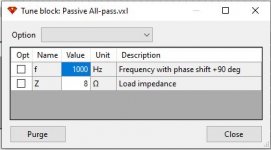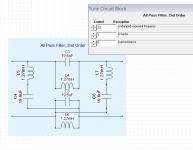Before take on my main steer speakers rebuild, I thought I'd have some cheap experimental fun with my desktops and play with time alignment on a flat baffle.
I have not seen reference to the Bridged T filter being used. Only comments on the all-pass phase filter. Nor have I seen any handy-dandy WEB calculators for either.
Any experience?
I have not seen reference to the Bridged T filter being used. Only comments on the all-pass phase filter. Nor have I seen any handy-dandy WEB calculators for either.
Any experience?
The first question I have is what exactly you hope to "align"?
Also, if you are looking for circuit description/analysis and design, you might need to look for a classic textbook on analog filter design.
Also, if you are looking for circuit description/analysis and design, you might need to look for a classic textbook on analog filter design.
Last edited:
How about you start with some appropriate responses and timing, then we can explore ways to do it.
Experimenting. Playing with my desktop speakers (Fe-85 and cheap tweeters.) Just experimenting as I have not used either network before.
Have you done it the conventional way before, or are you only interested in all-pass filters at the moment?
Done it the conventional way for 40 years. I am looking at things I have not done. Interested in both all pass ( phase shift) and Bridged T, which is more time based. Looking to anyone who has played with these and being a bit lazy, if there are any online calculators or crossover CAD which can encompass these circuits. I usually use PSD Lite which is very "lite." Enough to get a prototype so I can tune to reality.
You would be thinking of a Lattice Delay Network. Both it and the Bridged T are all-pass filters.
The lattice delay network can be configured to present a resistive load, and may be the easier to use.
The lattice delay network can be configured to present a resistive load, and may be the easier to use.
Take a look at Zaph's ZD5 writeup: Zaph|Audio - ZD5 - Scan Speak 15W8530K00 and Vifa XT25. It's the best explanation I've found about using a ladder delay network. He used SoundEasy which has a calculator, but tweaked it by measurements. Also: VituixCad (free) implements ladder delay networks, but I don't know if it has a calculator.
I'll look at Vituix. I have it, just never used it. I had SoundEasy and that was the proof of the old marketing rule: "take your worst attribute and advertise it" EASY it was not. I don't think I ever got through a complete design with it.
Yes, ladder and bridged T are both all pass, but one is a fixed phase shift, the other time, if I am reading the description correctly. Which is appropriate has to look at the driver phase, not just offset.
Yes, ladder and bridged T are both all pass, but one is a fixed phase shift, the other time, if I am reading the description correctly. Which is appropriate has to look at the driver phase, not just offset.
A ladder network and a lattice network are different.
You talk of phase shift but it can be configured as delay for a special case behaviour.
Yes, you need to understand the relationship between phase and delay, and make the connection. (It is recent active crossover talk that has separated the two, you need to go back to electronics basics.)
You talk of phase shift but it can be configured as delay for a special case behaviour.
Yes, you need to understand the relationship between phase and delay, and make the connection. (It is recent active crossover talk that has separated the two, you need to go back to electronics basics.)
Perhaps you are saying that all crossover simulators can do this?Also: VituixCad (free) implements ladder delay networks, but I don't know if it has a calculator.
All free-form simulators should be able to do it, yes. VituixCad lets you tune the ladder network for frequency and load impedance which may be unique.
Attachments
Last edited:
- Home
- Loudspeakers
- Multi-Way
- All pass or bridged T

